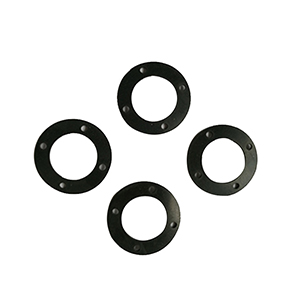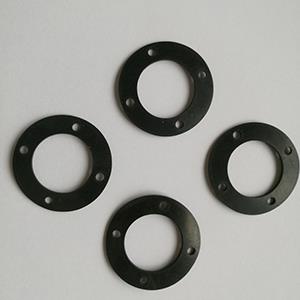
Rubber gasket
Rubber gasket Peng Nuo PN2600
Rubber gaskets are widely used in a wide range of gaskets. They are vulcanized with a polymer. Adding fillers, pigments and various additives to form a synthetic rubber. They have excellent compressibility and resilience, and only require a very low preload. It has an effective sealing effect under low temperature and low pressure conditions, easy to disassemble and can also achieve good sealing effect on uneven sealing surface. Because rubber has good expansion and permeability resistance, it is resistant to gas and fluid. A very effective seal is formed. Commonly used rubber gasket materials are natural rubber, nitrile rubber, neoprene rubber, ethylene propylene rubber, silicone rubber, fluorine rubber and the like.
Rubber gasket performance characteristics:
Natural rubber (NR) The natural rubber after vulcanization has high elasticity, high mechanical strength, resistance to bending, tearing and impact resistance. It has good corrosion resistance to alkali and dilute acid, is not resistant to non-polar solvents, and has poor oil resistance. It is easy to age under the action of oxygen and ozone.
NBR has excellent oil resistance. Its oil resistance is second only to polysulfide rubber, polyacrylate rubber and fluororubber in existing rubber. It also has the mechanical strength and wear resistance required as a sealing material. Performance is widely used in various dynamic and static seals. The combination of nitrile rubber and polyvinyl chloride can further improve its ozone resistance, wear resistance and flame retardancy. It can also improve its ozone resistance and low temperature bendability when used in combination with EPDM rubber. The oil resistance and low temperature properties of NBR have a great relationship with the acrylonitrile content.
Neoprene (CR) Neoprene is a self-reinforcing elastomer that is second only to nitrile rubber. Its physical and mechanical properties are similar to natural rubber. Its aging and chemical resistance are superior to natural rubber. It is a general rubber. A good one. Oil resistance is second to natural rubber and superior to other general rubber. It is resistant to corrosion by inorganic acids and alkalis and is a flame retardant rubber.
EPDM The copolymer of ethylene and propylene is excellent in ozone resistance, aging and weather resistance, and has excellent electrical insulation resistance to corona. Especially in high pressure water vapor, it has excellent corrosion resistance, so it can be used as high pressure water vapor. The gasket of the device, ethylene propylene rubber has good stability to various polar chemicals, ethanol, ketoester and acid-base, phosphate ester working oil. And sex is cheap.
Silicone rubber (SI) Silicone rubber has a wide temperature range (-100~+350°C), excellent resistance to oxygen, ozone aging, photoaging and weathering, good electrical insulation, high gas permeability, physiological inertness and mildew resistance. Outstanding, special silicone rubber also has oil resistance, radiation resistance and fire resistance. The disadvantages of silicone rubber are low strength, poor acid and alkali resistance, and high price.
Fluororubber (FPM) Fluororubber is excellent in oil and high temperature resistance and is comparable to silicone rubber. It is characterized by high corrosion resistance. It is suitable for organic liquids (such as various oils, fuels, solvents, hydraulic fluids). The concentration of hydrogen peroxide and other strong oxidants is superior to other rubbers. Domestic fluorine rubber is divided into two categories, namely type 23 and type 26 fluororubber. Type 23 fluororubber is more resistant to strong oxidizing acids than Type 26, but is less resistant to aromatic solvents, chlorine-containing organic solvents, fuel oils, hydraulic oils, greases, and boiling water than Type 26.
Rubber gaskets use the industry: chemical, petrochemical, oil refining, chlor-alkali, acid, phosphate, pharmaceutical, pesticide, chemical fiber, dyeing, coking, gas, organic synthesis, food, beverage and other production and processing departments.
Equipment used: sealing parts for pipes, valves, pumps, pressure vessels, heat exchangers, condensers, generators, air compressor connections
Rubber gasket technical standards:
GB/T 9126-2008|Non-metal flat gasket size for pipe flange
GB/T 17727-08|Non-metal gasket size for marine flanges
HG/T 20627-2009|Non-metal flat gasket for steel pipe flange (Class series)
HG/T 20606-2009|Non-metal flat gasket for steel pipe flanges (PN series)
HG/T 2700-1995|Test method for sealing of rubber gaskets
GB/T 5574-2008|Industrial rubber sheet
HG/T 4070-2008|silicone rubber sheet
Available in any standard and non-standard sizes, including ASME, DIN, JIS, GB and other standards. Available in round, square and other shaped shapes, and reinforced strip rubber gaskets are available upon request.


